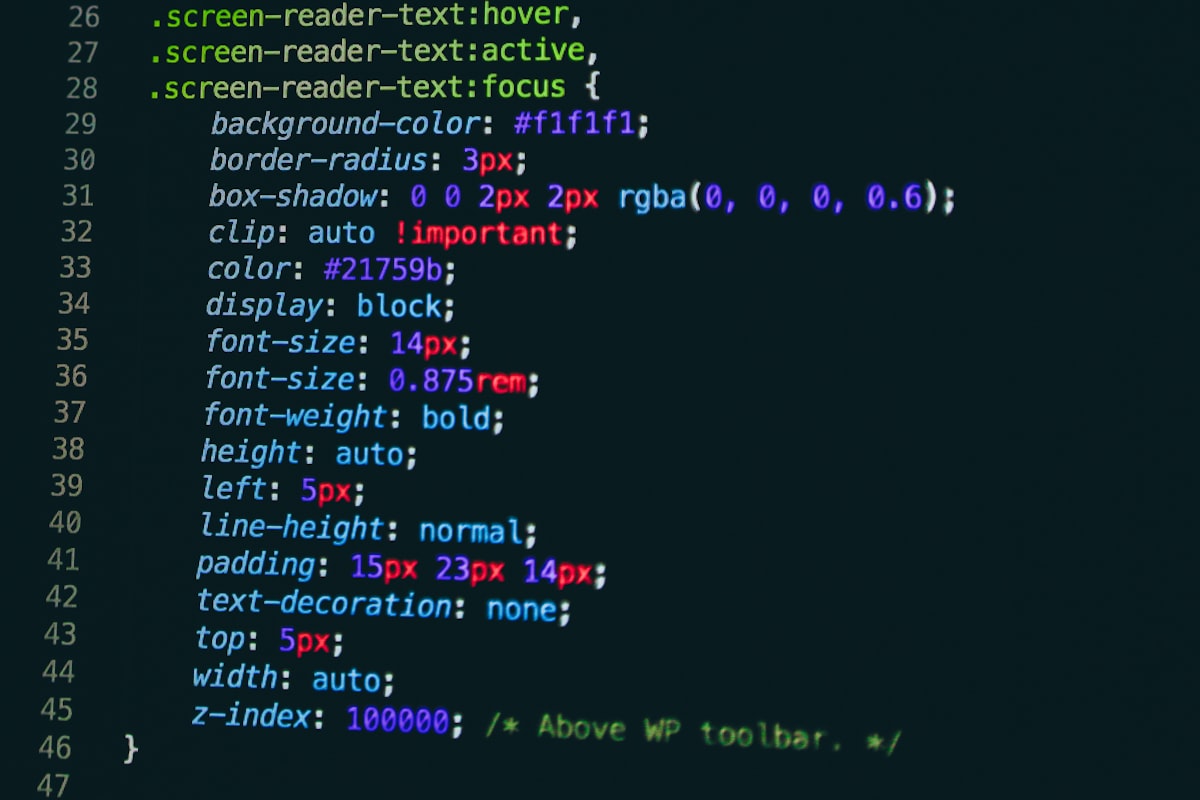1. Introduction to CSS Refactoring: Why It's Important
Ah, the mysterious world of Cascading Style Sheets! It's like that one room in your house that starts off clean, but over time, collects an assortment of clothes, gadgets, and who-knows-what. Before you know it, it looks like a hurricane went through it. That's your CSS after several iterations, updates, and maybe a few midnight snack-inspired coding sessions. But, here's the twist: instead of an intense cleaning spree, in the web realm, we call this magical tidying process "CSS Refactoring."
So, why is CSS refactoring the superhero we didn't know we needed? Think of it like a wardrobe makeover for your website. It's all about keeping things fresh, efficient, and fabulous. Just as you wouldn't wear those neon parachute pants from the '80s (or would you?), your website shouldn’t be flaunting outdated styles either. Refactoring is your ticket to a digital runway, ensuring your website doesn't just function, but it dazzles!
And if we dive deep into the SEO ocean, search engines love clean, efficient coding. It's like presenting them with a gourmet meal instead of a messy buffet. The better your code's structure, the more likely the search engine crawlers are to give you a virtual nod of approval. So, CSS refactoring isn't just about aesthetics; it's about moving up in the digital world's social ladder. If there was ever a cocktail party for websites, you'd want yours to be the talk of the evening, right? Cheers to a more refined, efficient, and swanky web presence!
2. Recognizing the Need for CSS Code Overhaul
Just like a detective looking for clues in a grand mystery novel, spotting signs that your CSS needs a spruce-up can be equally thrilling. Okay, maybe "thrilling" is a stretch, but let's face it, we’re CSS aficionados here!
Imagine this: Your website is a grand ship sailing the vast digital sea. As you add more content and features, it's like adding extra cargo. And with every extra line of CSS, it's akin to a barnacle clinging to the ship's hull. Over time, these barnacles (or messy CSS, in our case) can slow down your ship, making it less agile and responsive. What might've started as the Queen Mary, now feels more like a rickety old raft.
So, how does one recognize the sirens singing of an impending CSS apocalypse?
- The Slow-Loading Serenade: If your website takes its sweet time to load, that’s your first red flag. Users today have the patience of a goldfish with a caffeine addiction. If it doesn't load swiftly, they're off to the next digital lagoon.
- The Jumbled Jungle: When adding a single style feels like defusing a bomb because you fear it'll break something else, you’re deep in the CSS wilderness. It's time to machete your way out!
- Outdated Oasis: If you find CSS elements referencing features or content no longer on your site, you're basically hoarding digital ghosts. Time to set those spirits free!
- Compatibility Conundrums: Notice that your website is the epitome of beauty on one browser but resembles abstract art on another? Cross-browser incompatibilities scream "overhaul needed!"
But fear not, dear web warriors! Recognizing the need is the first step. Once you see the signs, you're already on the path to rejuvenation. In the words of the web wizards, "To refactor or not to refactor?" Now, you have the crystal ball to answer. Let's embark on this digital treasure hunt, ensuring your website remains the crown jewel of the internet realm!
3. Essential Tools and Resources for CSS Refactoring
Just like a master chef requires the finest of utensils to craft culinary masterpieces, the digital artisans (yup, that's you!) need top-tier tools to sculpt their CSS canvases into digital delights. Ah, the joys of web refinement!
Now, imagine venturing into the enchanted forest of CSS without a map, compass, or magical elixir. Sounds perilous, right? Fear not, for I'm about to equip you with a satchel filled with tools that are nothing short of digital wizardry.
- CSS Linting Magic: Tools like Stylelint or CSSLint are your trusted sentinels, scanning your code for potential pitfalls or style discrepancies. Consider them the ever-watchful owls in your coding forest.
- The Potion of Preprocessors: Ah, Sass and LESS! These preprocessors are the potions that give your CSS superpowers. They help break down your stylesheet into manageable, reusable modules, and even sprinkle in some logic for an added flair.
- Browser Spell-Books: Tools like BrowserStack and CrossBrowserTesting allow you to test your refactored CSS across various browser realms. Think of them as your trusty crystal balls revealing visions of compatibility.
- Compression Cauldrons: Post-refactoring, tools such as CSSNano and CleanCSS stir your CSS in their cauldrons, squeezing out every unnecessary byte to brew the most optimized potion.
- The Enchanted Repository: Platforms like GitHub or Bitbucket serve as your code's sanctum sanctorum. As you refactor, you can save versions, track changes, and collaborate with fellow mages, ensuring that no incantation goes awry.
The realm of CSS refactoring is vast and rich, brimming with tools that can make your quest feel less like a treacherous trek and more like a stroll in an enchanted garden. So, as you embark on your journey to sculpt and refine, remember: the right tool can make all the difference between a spellbinding site and a digital dud. Time to sharpen those coding wands and let the magic flow!
4. Breaking Down the Refactoring Process Step-by-Step
Welcome, dear readers, to the grand theatre of CSS Refactoring! Today's show? A mesmerizing ballet, choreographed in the language of code, and danced by... well, mostly you and your keyboard. Without further ado, let's break down the enchanting steps of this digital dance:
- Curtain Raiser – The Audit Waltz: Begin with an intimate dance with your current CSS. Understand its twists, twirls, and occasional missteps. Tools like CSS Stats can provide an insightful overview, revealing any redundant selectors or overweight properties.
- En Pointe – Setting Clear Goals: Are you aiming for a speedier website? Or a more responsive design? Knowing your dance's end pose ensures you twirl in the right direction.
- Jazz Hands – Cleanup Routines: Tackle the low-hanging fruits first. Remove any deprecated rules, consolidate duplicate styles, and sweep away the cobwebs of unused code. Think of this as shaking off any unnecessary jazz hands that don't fit the choreography.
- The Tango of Modularization: Divide and conquer by breaking your CSS into logical, modular files. Each section – be it navigation, footer, or hero – can have its own dance routine, making it easier to manage and maintain.
- Ballet Leaps with Variables: Using preprocessors like Sass, replace repeated values (like colors or fonts) with variables. This isn’t just efficient – it’s a graceful leap towards consistency.
- Cha-Cha with Comments: Dance is expressive, but sometimes, a few notes for clarity can help. Insert comments to outline sections or explain complex choreographies, ensuring future dancers (or developers) can follow along.
- Rehearse with Test Drives: Every great performance requires rehearsals. Test your refactored CSS in various browsers using platforms like Can I Use. Iron out any missteps before the final show.
- Finale – Optimize & Compress: As the curtain begins to fall, ensure your performance is crisp. Use tools like CSSO to compress your stylesheet, ensuring your site glides smoothly across the digital stage.
- Encore – Continuous Reviews: The dance of refactoring never truly ends. Regularly revisit, review, and refine to keep your digital ballet en pointe.
With the right steps and a sprinkle of passion, the art of refactoring transforms from a daunting task into a delightful dance. It’s not just about creating cleaner code, but crafting a masterpiece worthy of a standing ovation in the digital auditorium. Take a bow, maestro! Your stage awaits.
5. Best Practices for Organizing and Naming CSS Selectors
Ahoy, fellow code wranglers! Setting forth on the wild frontiers of the digital savannah, you might occasionally stumble upon the elusive "selectoritis." A malady where CSS selectors spiral out of control, roaming wild and untamed. Fear not! For I bring tidings of organization and wisdom. Behold, the golden scrolls of organizing and naming CSS selectors:
- The Timeless ‘OOCSS’ Map: Pioneered by the legendary Nicole Sullivan, Object-Oriented CSS (OOCSS) is like a compass guiding you to segregate container and content. With this, you avoid redundancy and embrace reusability.
- The BEM Beacon: BEM (Block, Element, Modifier) is a naming methodology that shines light on the relationship between your HTML and CSS. It's like leaving breadcrumbs in a dense forest, ensuring you always find your way back to logic.
- The SMACSS Spell: Scalable and Modular Architecture for CSS (SMACSS) divides styles into categories, casting a spell of sanity on your stylesheets and making them more predictable.
- Hierarchical Harmony: Always structure your CSS selectors in order of their hierarchy in the HTML document. It’s the natural flow of the universe, or at least, of well-organized code.
- Names of Nobility: Make your selector names descriptive, not prescriptive. A
.button-redcan mislead when the day comes that your button turns blue. Rather, a.button-primaryremains timeless and regal. - Shun the Specificity Sorcery: Beware of the dark arts of over-specificity. Instead of concocting spells like
#header nav ul li a, simplify to a humble.nav-link. Your future self shall sing ballads of your wisdom. - Dance with Data Attributes: In times of dynamic content and JavaScript interactions, using
data-attributes can be like waltzing with the stars. It ensures your styles and scripts play in delightful harmony. - Comment Chronicles: Leave behind tales of your intent, section breaks, or explanations with comments. Think of them as tiny scrolls ensuring that the legends of your code live on.
- Conserve with Constants: If certain values reappear, like a theme’s primary color or main padding, consider them the constants of your kingdom. Name them accordingly, ensuring they stand tall amidst other selectors.
Gone are the days where .btn-1234 or .lefty-lou roamed the wilds of our stylesheets. In this age of enlightenment, clarity and organization reign supreme. Armed with these best practices, you are now the knight in shining armor, ready to bring order to the digital realm. Onward, noble coder! The kingdom of well-organized CSS awaits your valor!
6. Leveraging CSS Preprocessors for Efficient Refactoring
Gather 'round, fellow digital alchemists, as we journey through the arcane halls of CSS preprocessors! These wondrous tools, with names reminiscent of powerful spells, can transmute your CSS refactoring from a laborious chore into a mystical art form.
- The Saga of Sass: Sass, or Syntactically Awesome Stylesheets, is not just a play on words but a potion of productivity. With its nesting abilities, variables, and mix-ins, Sass is the Merlin of CSS preprocessors. Fancy a quick color swap across your entire site? With a wave of the Sass wand, consider it done!
- The Legends of LESS: LESS, the other stalwart in the arena, offers functions and operations that feel like you're solving the Da Vinci Code of web design. With LESS by your side, you're not just refactoring; you're weaving prophecies of pixel perfection.
- Variables: The Philosopher's Stone: Both Sass and LESS bestow upon thee the power of variables. Changing a frequent value? Modify it in one sacred spot, and watch it ripple through your stylesheet like a charm.
- Mix-ins and Functions: The Elixirs of Efficiency: Need to reuse a particular style or calculation? Mix-ins and functions are the elixirs you seek. They're like your trusted spell recipes, ensuring consistent enchantment across your digital tapestry.
- Nesting Narratives: Instead of endlessly repeating selectors, preprocessors offer the gift of nesting. It's like crafting an epic tale, where each chapter (or selector) naturally flows from the previous, painting a cohesive picture of style.
- Modular Mystique with Partials: Splitting your styles into separate files, or "partials", is akin to the ancient art of scroll organization. When the time comes for compilation, these scrolls unite into a singular, optimized tome of CSS brilliance.
- Guardians of the Stylesheet – Linters: To ensure your preprocessed CSS remains pristine, tools like Stylelint act as guardians, gently (or sometimes, not so gently) guiding your code back to the righteous path.
In the chronicles of web design, preprocessors are the legendary artifacts, amplifying the powers of mere mortals. When leveraged correctly in the dance of refactoring, they can save not just hours but entire epochs of time. So, as you embark on your next refactoring quest, harness the might of preprocessors and let the annals of history sing praises of your digital alchemy!
7. Common Pitfalls and Mistakes to Avoid in CSS Refactoring
Ah, the siren song of CSS refactoring! While it promises shores of streamlined code and pixel-perfect design, many a brave coder has been lured into treacherous waters by common missteps. Fear not! For I shall be your lighthouse, guiding you away from these perilous pitfalls.
- The Overzealous Overhaul: Much like Icarus soaring too close to the sun, it's easy to get carried away. Avoid completely rewriting everything. Instead, refactor in iterations, testing as you go. Remember, it's not about reaching the sun; it's about optimizing the flight.
- Specificity's Slippery Slope: In an attempt to force a style, one might be tempted to use
!importantor overly specific selectors. Beware! This path leads to a tangled web of styles harder to untangle than the Gordian Knot. - Relying Solely on Tools: While tools like CSSLint or PurgeCSS are akin to having a trusty steed, solely relying on them is folly. Manual reviews ensure that you're not discarding essential styles or overlooking nuances.
- Not Testing Across Realms (Browsers): A site may look like a dream in Chrome, but appear as a nightmare in Internet Explorer. Cross-browser testing, using platforms like BrowserStack, ensures your refactoring magic shines consistently across all realms.
- The Mythical Magic Number: Using magic numbers (fixed values that "just work" for the situation) is akin to building on quicksand. As content or viewport changes, these numbers may lose their magic, leading to layout labyrinths.
- Ignoring Responsive Rituals: In the era of multiple devices, forgetting to test different breakpoints during refactoring can lead to mobile mayhem or tablet turmoil. Always ensure your refactored styles sing harmoniously across all devices.
- The Perils of Copy-Paste: Beware the alluring ease of Ctrl+C and Ctrl+V. Without understanding or tailoring the borrowed code, one risks invoking unforeseen digital demons.
- Sacrificing Readability for Compactness: While it's tempting to craft the most compact spell (code), remember that other wizards (developers) might need to decipher your incantations. Balancing brevity with clarity is the mark of a true coding conjurer.
- Overlooking Legacy Limitations: Historical scripts, plugins, or dependencies might rely on old styles. In your quest for the new, ensure you don't inadvertently banish critical elements from yesteryears.
The journey of CSS refactoring is filled with promise but also riddled with challenges. However, with foresight and caution, one can navigate safely, avoiding these common pitfalls and emerging as the heralded hero of harmonious HTML. May your refactoring adventures be ever triumphant, and may your stylesheets forever sparkle in the digital firmament!
8. Achieving Faster Load Times with Optimized CSS
Hold onto your hats, speed enthusiasts, because we're about to turbo-charge your site's load times using the nitrous oxide of the web world: optimized CSS! As digital drag racers, we know that every millisecond counts. So, buckle up and let's fine-tune that CSS engine for the ultimate digital speedway experience.
- Minification Magic: Think of minifying your CSS as streamlining your racecar. Tools like CSSNano and CleanCSS strip away all the unnecessary comments and whitespace, letting your stylesheets glide through the digital wind with ease.
- The Delight of GZIP Compression: By enabling GZIP on your server, you’re essentially putting your CSS on a diet, shedding those bulky bytes. It's the aerodynamics of web performance, ensuring your code reaches browsers at lightning speed.
- Critical CSS Celerity: By isolating and inlining the 'above-the-fold' CSS, you ensure that users get a visual treat instantly. It's akin to a sprinter's explosive start, grabbing the audience's attention right from the get-go.
- Cache Crusading: Implementing browser caching for your stylesheets is like giving return visitors an express pass. Since they've been to the racetrack before, there’s no need to wait in line again!
- Sprite Sprints: Combine multiple images into a single sprite sheet, reducing the number of requests. It's like consolidating pit stops in a race, ensuring you spend more time speeding and less time waiting.
- Limiting Layout Thrash: Excessive recalculations of styles can hinder performance. By optimizing and grouping style changes, you reduce this digital dance, ensuring a smoother ride.
- Shun the Shadows of Render-Blocking: External stylesheets can hold up the rendering party. By optimizing their order or using asynchronous loading, you ensure your content is displayed faster, much like a drag racer's perfect launch.
- Use the Power of Preload: Preloading critical resources, like fonts or high-priority stylesheets, is like revving your engine before the race. By the time the green light flashes, you're already at peak power.
- Purge Unnecessary Properties: Tools like PurgeCSS help you declutter your code by removing unused styles. It's the equivalent of removing excess weight from your vehicle, making it race-ready.
- Embrace Modern Formats: Use modern formats like CSS Grid and Flexbox where appropriate. They are the efficient engines of the design world, ensuring your layouts adjust and load swiftly.
In the grand prix of web performance, optimized CSS is your trusted pit crew, ensuring every tweak and tune-up propels you towards the finish line faster. So, next time a user visits, they won't just be browsing; they'll be experiencing the exhilaration of Formula 1, all thanks to your streamlined styles! 🏁 (Oops, I slipped an emoji in there for the finish. My bad!)
9. Concluding Thoughts: The Long-Term Benefits of CSS Maintenance
As we coast to the conclusion of our digital odyssey, it's time for a moment of profound reflection. Much like the diligent gardener who, with persistent care, ensures their garden remains a haven of serenity and beauty, CSS maintenance is an ongoing journey, a labor of love. But what flowers bloom from this incessant tending? Let us elucidate.
- Future-Proofing Fantasia: Regular CSS upkeep ensures your code remains compatible with the ever-evolving browser landscape. You're not just coding for today; you're crafting for the digital epochs to come.
- Monetary Marvels: Optimized and streamlined CSS translates to faster page loads. And in the e-commerce universe, faster pages directly correlate to higher conversions. Every byte saved could be a dollar earned!
- Onboarding Odyssey: Clean, organized CSS ensures that new team members (whether junior devs or seasoned pros) can dive into the code with ease. An understandable codebase is like a warm, welcoming inn on the treacherous coding journey.
- Debugging Delight: An oft-overlooked gem! Maintained CSS simplifies the bug-hunting process. No more spelunking in cavernous stylesheets; find and fix issues with the grace of a hawk spotting its prey from the heavens.
- Scalability Symphony: As your platform grows and evolves, so too will its styles. Regular CSS maintenance ensures this growth remains harmonious, more symphonic orchestra and less cacophonous street band.
- User Experience Utopia: At the heart of it all, refined CSS curates a consistent, delightful user experience. It's the invisible puppeteer orchestrating a seamless dance between content and user.
- Green Coding Graces: Believe it or not, optimized code, leading to reduced computation and faster loads, has a smaller carbon footprint. Every line of sleek CSS is a step towards a greener, more sustainable digital realm.
- Mental Serenity Sanctuary: Let's not forget the intangible, yet invaluable, peace of mind. Knowing your CSS is in top form, free of redundancies and conflicts, allows you to sleep the sleep of the just.
So, as the sun sets on our CSS escapade, let's remember that refactoring and maintenance aren't just chores on a checklist. They're an investment, a tribute to the past work, and a bridge to future marvels. Every minute spent refining and nurturing your stylesheets is a testament to your commitment, not just to impeccable code, but to the boundless potential of the web.
Dear reader, as you step forth, may your styles forever cascade gracefully, and may your websites shimmer in the eternal glow of digital excellence!








